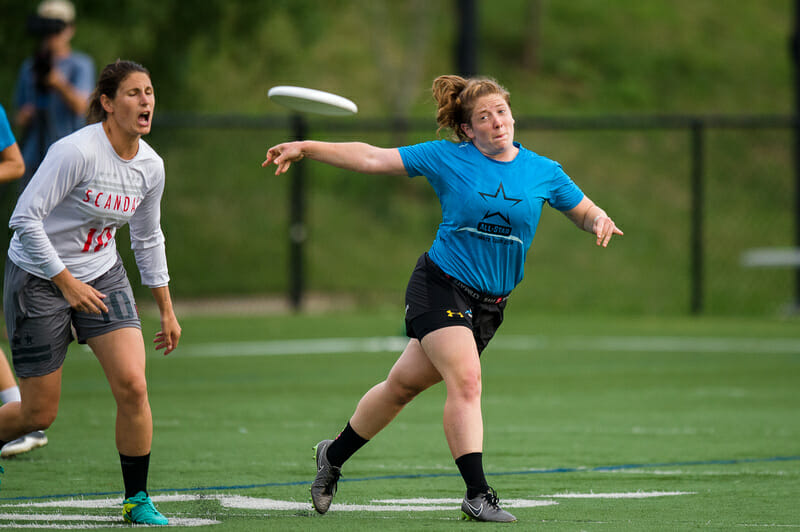3 tips to help get your brain and body primed to perform.
August 23, 2022 by Melissa Witmer in Opinion with 0 comments

We’ve all had the experience of being in the zone. Time seems to slow down. All of our choices pan out. We feel like we can do no wrong! Why can’t we play this way all the time?
But getting to that mental space is more in our control than you might think.
What is Being In The Zone?
Being in the zone is characterized by a few things:1
- Our ability to track time is distorted and things slow down.
- We have enhanced focus.
- Activity in the cerebral cortex (the logical part of the brain) diminishes.
- We feel a loss of ego, and a loss of self-judgment or self-consciousness.
This allows our sports brain (or nonverbal brain) to take over and simply do the job we’ve trained it to do.
I had a client once ask me, “Well, if all that happens, is it me really doing it?” This is a philosophical and relevant question which also explains why it’s difficult to get in the zone more often. The ego (our sense of self) really really wants to be involved. But, in fact, being involved or the act of trying to get in the zone is an act of the ego – and an act of the conscious brain. We need this part of the brain to be quiet in order for a real flow state or in the zone state to occur.
So instead of overthinking the act of getting to that state, I like to encourage folks to think about “setting the table” and inviting the flow state to show up.
How can we get better at inviting our flow state? Here are three quick tips to help you get into the mental state that is conducive to your best performance:
1. Use Your Body to Tune Your Nervous System
We all have an optimal state of excitement (state of arousal in sports science) where we perform our best. This will vary from person to person. And maybe it varies even in the same players from offense or defense.
In general, if your state of arousal is too low, you’ll be sluggish, not physically moving at your top speed, maybe lacking a bit of focus. If your state of arousal is too high, you might be making decisions too frantically (conservation or greatness anyone?) or your vision narrows and you honestly did not see that poacher in the lane (oops!)
Take control over your own arousal state by using your body to communicate what you want.
To decrease your arousal state, use deep breaths. Bring attention to your belly and initiate your breath from there. Notice your shoulders and neck. Can you release some tension with some gentle movement as you breathe?
To activate your nervous system and increase your level of excitement, do some tuck jumps, or 5-step accelerations. Anything that asks your muscles to fire at full intensity and full speed (assuming you’ve already done a physical warm up) will wake up your nervous system and your brain to enhance focus.
2. Be What You See – Using Visualization
You can probably remember at least one time you did something awesome on offense. And probably at least one time when you did something cool on defense.
Take advantage of the fact that your sports brain does not know the difference between imagination and reality. Visualize a few times when you did the things you’re best at, the times you made those good decisions or big plays.
This type of visualization can help put you back in the mental state you were in when you executed those types of things before.
3. Using Mantras
A mantra is a word or short phrase that you repeat over and over while doing other things. A mantra can serve many purposes.
First, it can help occupy your verbal brain and prevent it from overthinking and interfering with what your sports brain is doing on the field. If you suffer from negative self-talk, your brain is going to be talking to you anyway. This strategy helps you choose what it is talking about.
Second, these words or phrases can act to elicit the emotional state you want while playing your best. For example, “cool and collected” on offense or “Go! Go! Go!” on defense.
Third, they can act as coaching cues if you have specific strategic intentions you’re trying to execute in particular situations. For example, “no under, no under, no under” Or maybe something new you’re trying to incorporate into your game like “stay low, stay low stay low” if you’re working on better defensive athletic positioning.
Dive Deeper
The real secret to inviting your flow state is to make these mental training preparations part of your regular ultimate training habits. I encourage my clients to use these elements in their pre-performance routines before every game and every training session. While using these tips will likely help you right away, tweaking these elements over time for consistent results is even better.
If you’d like to learn how, come to my free workshop this week on 3 Mental Hacks to Get in the Zone where we’ll dive deeper into these concepts and I can help you develop your own pre-game performance routine.
Last thing: today we’ve talked about your mental preparation. To put the finishing touches on your physical preparation, read about your Pre-Tournament Workout so that you can be both mentally and physically ready for your peak performance.
Per Mihaly Csikszentmihalyi in “Flow: The Psychology of Optimal Experience” ↩